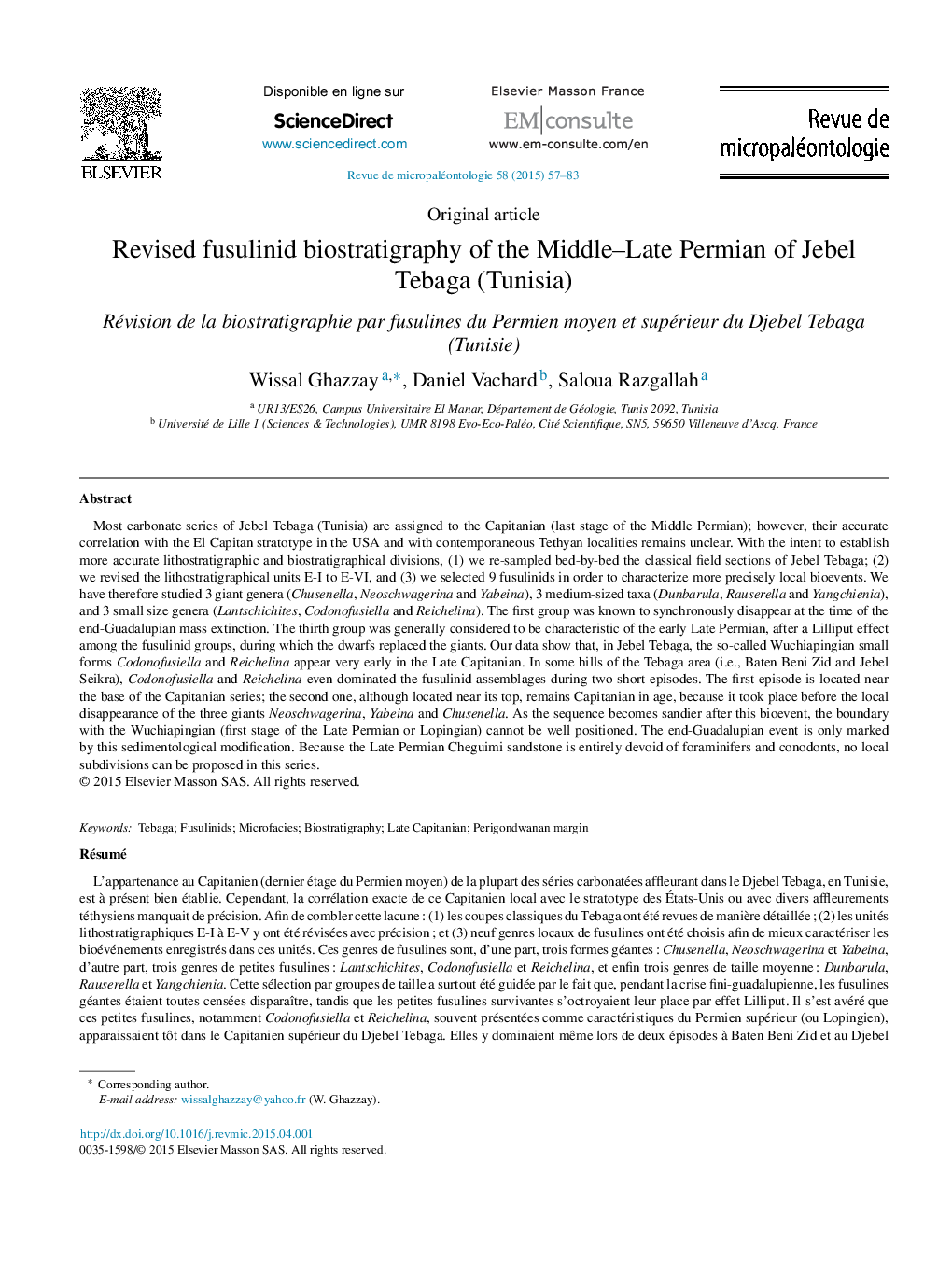| کد مقاله | کد نشریه | سال انتشار | مقاله انگلیسی | نسخه تمام متن |
|---|---|---|---|---|
| 4751416 | 1361058 | 2015 | 27 صفحه PDF | دانلود رایگان |

Most carbonate series of Jebel Tebaga (Tunisia) are assigned to the Capitanian (last stage of the Middle Permian); however, their accurate correlation with the El Capitan stratotype in the USA and with contemporaneous Tethyan localities remains unclear. With the intent to establish more accurate lithostratigraphic and biostratigraphical divisions, (1) we re-sampled bed-by-bed the classical field sections of Jebel Tebaga; (2) we revised the lithostratigraphical units E-I to E-VI, and (3) we selected 9 fusulinids in order to characterize more precisely local bioevents. We have therefore studied 3 giant genera (Chusenella, Neoschwagerina and Yabeina), 3 medium-sized taxa (Dunbarula, Rauserella and Yangchienia), and 3 small size genera (Lantschichites, Codonofusiella and Reichelina). The first group was known to synchronously disappear at the time of the end-Guadalupian mass extinction. The thirth group was generally considered to be characteristic of the early Late Permian, after a Lilliput effect among the fusulinid groups, during which the dwarfs replaced the giants. Our data show that, in Jebel Tebaga, the so-called Wuchiapingian small forms Codonofusiella and Reichelina appear very early in the Late Capitanian. In some hills of the Tebaga area (i.e., Baten Beni Zid and Jebel Seikra), Codonofusiella and Reichelina even dominated the fusulinid assemblages during two short episodes. The first episode is located near the base of the Capitanian series; the second one, although located near its top, remains Capitanian in age, because it took place before the local disappearance of the three giants Neoschwagerina, Yabeina and Chusenella. As the sequence becomes sandier after this bioevent, the boundary with the Wuchiapingian (first stage of the Late Permian or Lopingian) cannot be well positioned. The end-Guadalupian event is only marked by this sedimentological modification. Because the Late Permian Cheguimi sandstone is entirely devoid of foraminifers and conodonts, no local subdivisions can be proposed in this series.
RésuméL’appartenance au Capitanien (dernier étage du Permien moyen) de la plupart des séries carbonatées affleurant dans le Djebel Tebaga, en Tunisie, est à présent bien établie. Cependant, la corrélation exacte de ce Capitanien local avec le stratotype des États-Unis ou avec divers affleurements téthysiens manquait de précision. Afin de combler cette lacune : (1) les coupes classiques du Tebaga ont été revues de manière détaillée ; (2) les unités lithostratigraphiques E-I à E-V y ont été révisées avec précision ; et (3) neuf genres locaux de fusulines ont été choisis afin de mieux caractériser les bioévénements enregistrés dans ces unités. Ces genres de fusulines sont, d’une part, trois formes géantes : Chusenella, Neoschwagerina et Yabeina, d’autre part, trois genres de petites fusulines : Lantschichites, Codonofusiella et Reichelina, et enfin trois genres de taille moyenne : Dunbarula, Rauserella et Yangchienia. Cette sélection par groupes de taille a surtout été guidée par le fait que, pendant la crise fini-guadalupienne, les fusulines géantes étaient toutes censées disparaître, tandis que les petites fusulines survivantes s’octroyaient leur place par effet Lilliput. Il s’est avéré que ces petites fusulines, notamment Codonofusiella et Reichelina, souvent présentées comme caractéristiques du Permien supérieur (ou Lopingien), apparaissaient tôt dans le Capitanien supérieur du Djebel Tebaga. Elles y dominaient même lors de deux épisodes à Baten Beni Zid et au Djebel Seikra. Après chaque épisode à Codonofusiella et à Reichelina, les fusulines géantes, qui réapparaissent, parfois assez massivement, indiquent que l’on reste dans le Capitanien. Par contre, on ne peut établir précisément pour l’instant si les niveaux à Dunbarula et à petits foraminifères, qui succèdent au dernier retour des Neoschwagerina, Yabeina et Chusenella, correspondent à l’extrême sommet du Capitanien ou à l’extrême base du Wuchiapingien. Rien d’autre qu’une sédimentation progressivement plus sableuse ne vient en effet marquer au Tebaga la grande crise de la limite du Permien moyen et du Permien supérieur. On n’enregistre en Tunisie, et sans doute dans tout le fond du cul-de-sac téthysien, que les effets d’une baisse progressive du niveau marin et de l’augmentation croissante d’apports siliciclastiques ; deux types d’influences qui pourraient n’être dus qu’à des phénomènes locaux. L’unité E-VI, ou grès de Cheguimi, représente probablement l’ensemble du Lopingien, mais, étant totalement dépourvue de foraminifères ou de conodontes, elle n’a pu être datée plus précisément. Au Tebaga, comme dans beaucoup de régions périgondwanes et cimmériennes, les foraminifères ne réapparaîtront qu’à la fin du Trias inférieur.
Journal: Revue de Micropaléontologie - Volume 58, Issue 2, April–June 2015, Pages 57–83